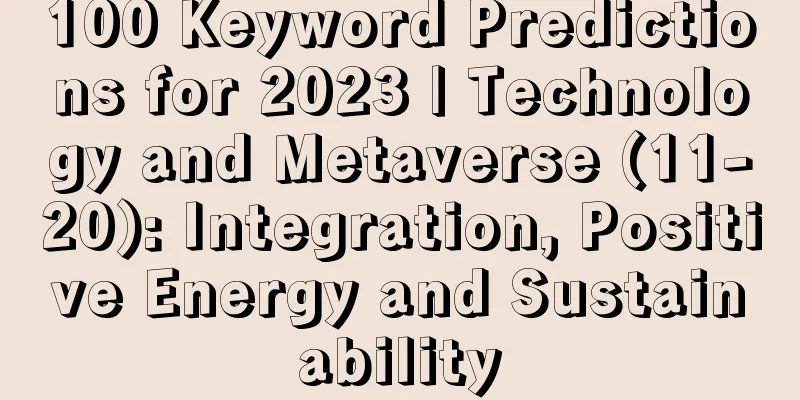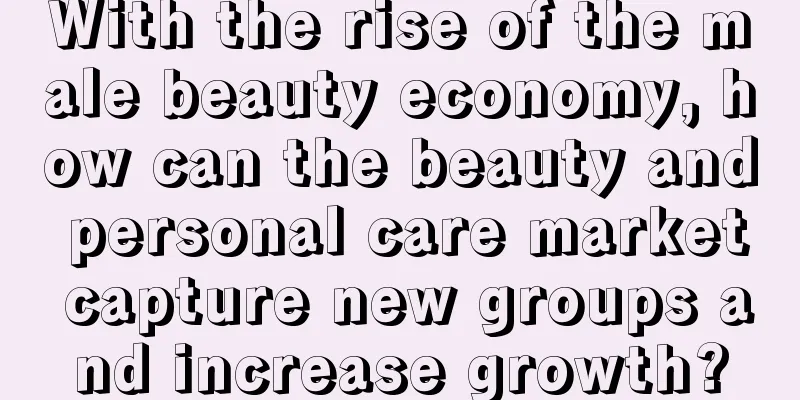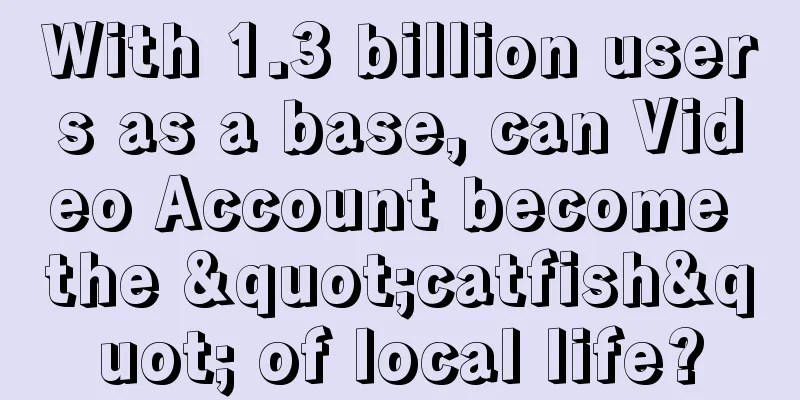100 Keyword Predictions for 2023 | Technology and Metaverse (11-20): Integration, Positive Energy and Sustainability

Continuing from the previous article "100 Key Words Predicted for 2023 | Culture (01-10): Vitality, Power and Excitement". Part 2: Technology and the Metaverse11. Technology Accessibility – Companies are redesigning their digital environments to make them more accessible.Designing around accessibility and inclusion is not only the right thing to do, it’s big business, especially when it comes to technology. With an estimated 1 billion people with disabilities and more than 5 billion internet users worldwide, brands should take this opportunity to upgrade their devices, platforms and experiences to create a more accessible environment for users. Josh Loebner, global head of inclusive design at Wunderman Intelligence, told Wunderman Intelligence: "Inclusive design is better design, and this consideration of technology has potential benefits for both people with disabilities and the general public." Big Tech has invested in this area. In September 2022, Twitter announced a new alt text tool designed to help those using screen readers read the platform's image content. Google is enlarging its widgets on Android devices to improve the experience for those with impaired vision, and Instagram is making accessibility a standard - as of March 2022, auto-generated captions on the platform's videos have become a default setting for creators. Innovative devices are also helping people create more accessible experiences. Software company XRAI Glass has teamed up with manufacturer Nreal to develop augmented reality (AR) glasses based on speech-to-text recognition technology. The concept glasses use AR technology to project real-time subtitles into the wearer's field of view, allowing deaf or hard of hearing people to understand and participate in conversations. The glasses are based on Nreal's existing design and can be connected to a smartphone, which handles the speech-to-text conversation. Why you should pay attention to this trend: Accessibility isn’t limited to the physical world. When designing digital experiences and environments, brands should consider how to better reach audiences of all abilities. As Loebner said, “Accessible technology has the power to create welcoming environments, communities, and experiences for marginalized groups.” 12. Digital identity - the trend of people integrating into the virtual world is becoming more and more obvious.As the Metaverse takes shape, how will users view their virtual identities? According to a report by Wunderman Intelligence, 76% of respondents in the United States, the United Kingdom and China who are familiar with the metaverse want to use their virtual avatars to express their personality in ways they cannot experience in the real or offline world. 51% of respondents believe that this virtual identity makes it easier for them to show their true self in the metaverse or digital world. Liam Young, a hypothetical architect and co-founder of urban futures think tank Tomorrows Thoughts Today, predicts a future where the boundaries between online and offline life disappear. “I think the words we use, like ‘digital’ and ‘physical’, are outdated,” he told Wunderman Intelligence. “We all live mediated lives that are extensions of our digital identities, and our screens can have a huge influence in the real world. It’s anachronistic to think of this digital life as a separate, independent thing.” This view is echoed by identity designer and beauty futurist Alex Box, whose work focuses on how we communicate our identities in creative ways and explores how technology can enhance people’s ability to express themselves. “Identity is about both the physical and digital worlds,” she told Wunderman Intelligence. “I think identity design is the next big step in how we express and interpret our multiple selves in the metaverse.” She said: "We already have multiple autonomous identities in our metaverse, including our self on social media, our self at work, our self at home, our self in thought, and so on. As we enter the Web3 era, we can imagine that these multiple selves will gain a kind of materiality, presence, or essence; we can learn through AI to automatically form and regenerate the emotional and thought 'texture' of these selves." Why you should pay attention to this trend: As digital lifestyles mature, people will begin to think more deeply about how to retain and switch between their identities in various virtual worlds. We will see more subtle expressions of identity in real and virtual environments. 13. Ritual ApplicationsThe next generation of social media apps is bringing a sense of ritual to user interactions — transforming the process into an experience worth savoring. In recent years, social media applications have used powerful and complex algorithms to maximize stickiness and design to attract consumers to continue to interact with them. But a new generation of applications is challenging this always-on approach, focusing on more valuable but less frequent experiences for users. The new movement is being spearheaded by French startup BeReal, whose app ranked number one on the social media download charts in the US, UK and Australian App Stores in August 2022. BeReal encourages users to establish a simple and pure daily operating ritual. It asks users to randomly select a time every day to upload a composite photo composed of two photos taken by them at that time, facing the camera and taking a selfie. This photo has no filters added, allowing users to share the real state of themselves and the surrounding environment at that time, and set it to be visible only to friends. Many existing social media apps are trying to add a sense of ritual by copying BeReal's feature.
These social media applications build user expectations and provide an interesting sense of ritual by limiting user stickiness rather than demanding unlimited user time, prompting people to interact in a more sincere way. Why you should pay attention to this trend: The phenomenon began with the desire to be authentic with one another on social media and the rise of Buddhist social networks, which encourage users to approach everyday life in a ritualistic way. 14. Philanthropic Metaverse – Brands are leveraging the Metaverse to advance global humanitarian initiatives.People are supporting humanitarian causes around the world through their digital consumption in the Metaverse. The humanitarian organization Built With Bitcoin Foundation uses 100% of its Built With NFT Collection proceeds to provide drinking water, school construction, sustainable agriculture, and humanitarian support to funded groups in Africa, Asia, and Latin America. The organization is powered by Bitcoin, and the Built With NFT Collection showcases artwork created by students from funded groups created by STXNFT on the Bitcoin network. Jamil Dhanani, founder of STXNFT, said: "Bitcoin has always been a force for good, enabling economic freedom for billions of people around the world. Projects like Built With NFT perfectly demonstrate this by allowing people to participate in meaningful causes in a low-key way." In April 2022, Epic Games and Xbox announced a $144 million fundraising effort to provide humanitarian support to Ukraine. As early as March, Epic Games had promised to donate all in-game sales revenue to this charity project before April 3, and Xbox also stated that it would donate revenue from the sale of game props in Fortnite. In November 2022, Saudi charity AP launched its latest innovative program on the Metaverse. A hub that combines multiple virtual spaces to provide users with an unparalleled digital and cultural experience. The program is in line with AP's mission to use the latest disruptive 3D technology to spread their message around the world to connect with the younger generation, thereby bridging the gap between cultures and promoting a more open and tolerant global community. Why you should pay attention to this trend: Digital branded products and services are breaking the boundaries of entertainment and benefiting the real world. Businesses are leveraging the agility, speed, and international reach of the Metaverse to easily aid and support charitable causes—and harnessing this power to transform the Metaverse into a platform for social good. 15. AR entertainment projects – AR technology has spawned a new form of entertainment.Brands are leveraging various tools to enhance the viewing experience and make movies more interactive. Disney released its first AR short film "Remembering" in September 2022. In an interview with TechCrunch, Disney said that this is the first AR application that directly connects to the content of the Disney+ platform and aims to test AR's ability to play movies and tell stories in home scenes. Disney will release an AR mobile game "Marvel World of Heroes" in 2023. Players can create superheroes, defeat villains, and team up with friends to play games on their devices. The in-game experience will be able to reflect each player's real-life location and background, similar to the game scenes in "Pokémon Go". At the Goldman Sachs conference in September 2022, EA CEO Andrew Wilson stated that the company plans to "invest in creating truly interactive content." He went on to state that EA has a "very unique and special opportunity to deliver on its vision for the future of entertainment" and expressed confidence in the company's 20% player-generated content, claiming that 50% of the company's players are using that content. Last year, a new reality show joined the film scene, starring characters from NFT projects BoredApe Yacht Club, Doodles, World of Women, and Cool Cat. Produced by the animation studio Invisible Universe, The R3al Metaverse features characters who suddenly find themselves in the real world, and fans can interact with them as they advance the plot, helping to create content for the show. Viewers who hold NFT producer passes can participate in the production of content, and avatar holders from selected projects also have the opportunity to appear in the show, playing their own characters. Why you should pay attention to this trend: AR technology is constantly changing the opportunities for audiences to interact with traditional passive entertainment programs, adding immersion and interactivity to the viewing experience. 16. Positive energy information flow - Social media information flow is transforming into a platform for providing positive energy.App designers are building new platforms to create positive environments. Gas is essentially a "rainbow fart" app that ranked first on the App Store's free download list for several weeks in 2022. Gas asks users to answer multiple-choice questions, but the questions are positively oriented and are designed to compliment their classmates and friends. The app targets teenagers and requires users to indicate their school and post compliments on the platform, while also incentivizing users to continue complimenting others, thereby creating a positive and harmonious application environment.
The Niche app introduces a new concept to social media - it displays user-controlled content rather than user-directed content. This decentralized Web3 app is open only to members (not users), allowing them to join various communities within the app based on their interests and real relationships. The content they post can attract positive interactions from like-minded people rather than getting likes and digital promotion opportunities.
Zaven Nahapetyan, co-founder and CTO of Niche, believes that the future of social media will be one where "people have the ability to choose and control their social interactions, just like in real life. People don't want to see content they don't want to see, and they can interact with people who are helpful and have common topics with them." Why you should pay attention to this trend: Consumers are seeking positive online interactions and emotional support, and emerging social media platforms are capitalizing on people’s desire for change by reshaping their feeds around positive content. 17. Metaverse Sustainability - What do sustainability initiatives look like in the Metaverse?Brands are extending their sustainability practices to the digital world to maintain eco-friendly platforms and achieve sustainability goals. In September 2022, the Ethereum cryptocurrency completed a software update that reduced its carbon emissions by 99%. As stated by the company, the merger transformed the original "proof of work" verification method to a more energy-efficient "proof of stake" (PoS) method, effectively reducing the cryptocurrency's electricity footprint from 8.5GW to less than 85MW. Some platforms have prioritized environmental initiatives from the outset.
According to Wunderman Intelligence’s “Regeneration Rising: Sustainability Futures” report, 86% of respondents want companies to play a role in addressing major issues such as climate change; 88% of respondents believe that companies should make sustainability a standard operating measure; and 89% of respondents believe that brands should do more to reduce their carbon footprint.
Why you should pay attention to this trend: Whether businesses are balancing their carbon footprint by adopting an eco-friendly blockchain or using a greener platform, there are many sustainability initiatives that brands can take advantage of to advance the Metaverse. 18. Metaverse Bank - Banks are redefining the concept of digital finance.Consumers can now purchase cryptocurrencies and use traditional banking services without leaving their homes. In August 2022, Decentraland partnered with Metaverse Architects to launch the first Metaverse ATM service and Transak payment gateway. Just like withdrawing cash in the real world, players can purchase cryptocurrencies through the platform, and property holders on the platform can also add an ATM machine to their virtual property to easily withdraw cryptocurrencies. JPMorgan Chase is the first bank to open a waiting room and office in the Metaverse. The bank's blockchain division, Onyx, released a report when launching the waiting room, describing the various opportunities provided by the Metaverse and mentioning that the Metaverse will "penetrate every industry in some way in the coming years." The bank has also invested in payment fintech company Tilla, which provides payment services for the Metaverse of games, virtual worlds, and mobile applications.
This interactive experience will demonstrate to consumers the importance of sustainable initiatives and prove that the Metaverse can be a force for good.
Why this trend is worth watching: Banking institutions are offering consumers one-stop services such as virtual commerce, consulting, meta-banking and purchasing cryptocurrencies. Banking may soon become a common element in the digital world. 19. Mapping reality - Why is navigation technology key to the future of Web3?Some of the world’s leading tech brands are tackling a seemingly basic task – mapping the real world. “We’re seeing the world’s most valuable and/or influential technology companies all using sensors and computer vision to map, read and understand the real world,” Aglet CEO Ryan Mullins told Wunderman Intelligence, pointing to tech giants including Tesla, Instagram, Apple and Snapchat.
Why are they all focusing on the map field?
Why you should pay attention to this trend: Mullins positions mapping as “the latest stage in the evolution of the internet,” one that moves digital engagement “from scrolling through a page to moving geographically.” Web3, therefore, is about more than blockchain and cryptography — it creates “a location-based internet. It’s not limited to pages and people, but it encompasses machine-readable reality itself.” 20. VR Dating – Will virtual reality (VR) become the next dominant force in matchmaking?Tinder revolutionized the online dating market a decade ago. Now, the Metaverse is ushering in a new era of love, allowing people to find partners in virtual worlds. In the metaverse, people date through interactions between virtual avatars, and the virtual reality dating app Nevermet has a strict rule - users are not allowed to display profile pictures. In an age where people are apparently used to judging each other by their online dating photos, Nevermet's rule is undoubtedly a bold move, but it also gives users the opportunity to connect in other ways.
From uninspired opening lines to commonplace date locations, people's first dates often lack surprises, but the VR dating app Flirtual can change that and allow people to have unexpected romantic experiences in the virtual world. The app, which was released in March 2022, offers thousands of dating options, such as swimming with sharks, observing black holes, and more. Planet Theta, a dating app, hopes to use the power of VR to get people to be honest with each other and get rid of fake online personas. Chris Crew, CEO of Planet Theta, told Wunderman Intelligence that the app will revolutionize the way users authenticate their identities and launch a feature that "can accurately identify whether your identity is suspected of fraudulent behavior." "It uses government records, online databases, past data breaches and other sources to determine if there is a connection between your name and the account email." Why you should pay attention to this trend: In the future, it’s possible that people will first establish romantic relationships in the metaverse. “It’s easier to fall in love with someone through VR than through any other digital medium,” said Anthony Tan, CEO and co-founder of Flirtual. VR could bring a whole new level of intimacy and get rid of some of the drawbacks of existing online dating platforms and apps. [To be continued] This article is from the official website of Wunderman Thompson: https://www.wundermanthompson.com/ Author: Brand Yuan, WeChat public account: Brand Yuan (ID: brand-yuan) |
<<: 4 modes, 7 content directions, factory owners can also do a good job on Douyin accounts
>>: Metaverse Marketing, PepsiCo Has Mastered It
Recommend
Summer is coming, how can brands play April marketing?
April is coming soon, and the April hot marketing ...
How to reverse calculate Xiaohongshu’s traffic budget?
Master the art of precise delivery on Xiaohongshu ...
Moutai frequently collaborates with brands: the 400-year-old brand is also working hard to fight against aging
This article explains the marketing strategy behin...
What are the characteristics of cross-border third-party payment platforms? Is it convenient?
Now everyone wants to do cross-border e-commerce, ...
I haven’t posted on WeChat Moments for a long time. Can I still monetize it?
This article explores the changes in people's ...
What is the Amazon FBA shipping process? Newbies must learn the shipping process
Amazon merchants need to solve logistics problems ...
Is it really a false proposition that local life aims at promoting products?
Meituan’s latest “Local Food” feature is regarded ...
Is it necessary to send Orange Union Payment on eBay? eBay Orange Union Payment Process
As one of the world's largest online auction a...
Guide to Asking for Help | Don’t let not knowing how to ask for help ruin your career!
I believe that the question of asking for help is ...
The battle for traffic is coming to an end, and community media will usher in a bonus era in 2022!
With the rise of the Internet, online traffic has ...
2022 Annual Review (I): The underlying logic of good products, good growth, and good sales
2022 has passed. Looking back on this year, many n...
In the era of consumption downgrade, which brands are popular in Japan? What lessons can we learn from them for the Chinese market?
Recently, consumption downgrade has swept across t...
Year-end review丨Live streaming sales in 2023: anchor or platform, who is the super IP?
Today, the live streaming e-commerce industry has ...
You watched the crisis public relations of BMW and MINI, and I saw the “5S airplane model” of workplace crisis management
For operations, you may encounter situations where...
2025 Consumption Outlook: Rational Consumption, Emotional "Breakthrough"
As 2024 comes to an end, we stand on the threshold...



![Xiaohongshu's popular article routine [May]](/upload/images/67e766e8936d6.webp)





